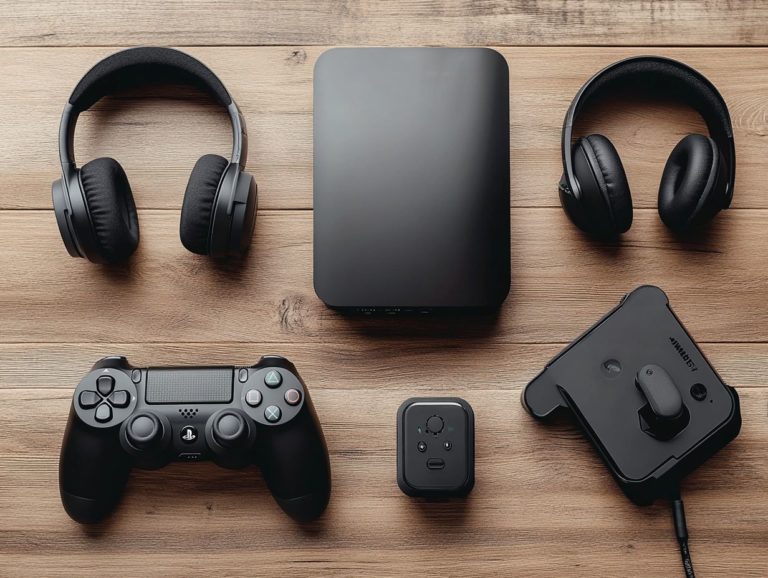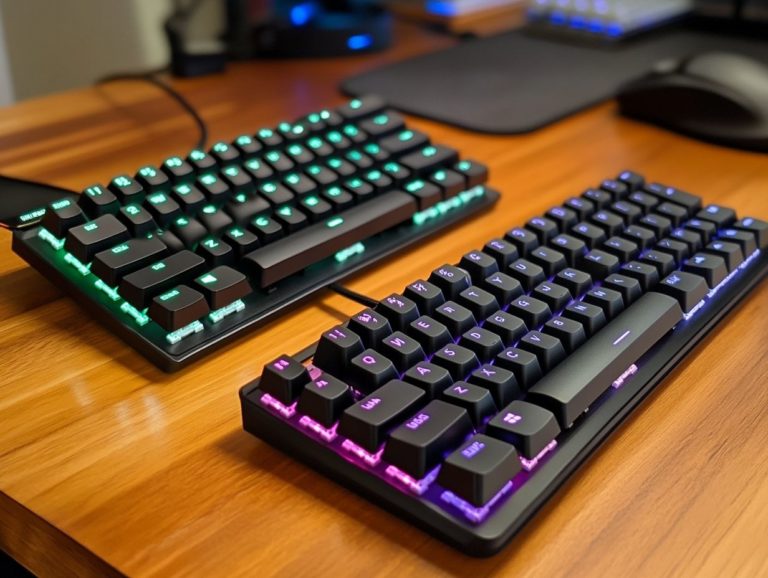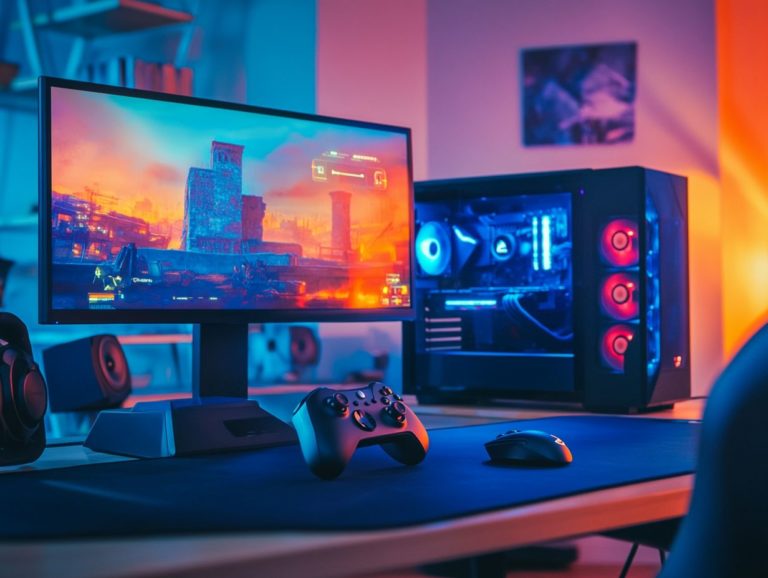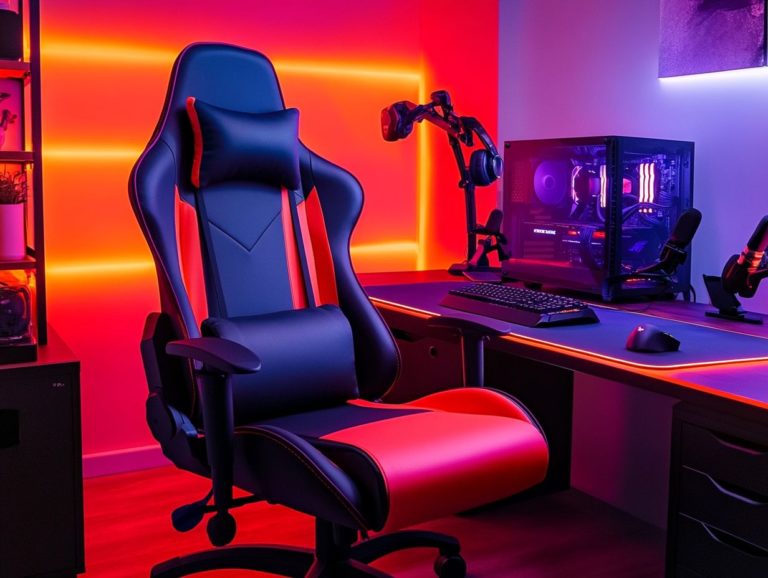what features should a gaming monitor have?
When it comes to gaming, the right monitor can truly elevate your experience. With so many options available, understanding what makes a monitor ideal for gaming is essential. Features like refresh rates and resolution play a significant role in creating seamless, immersive gameplay.
This guide explores the essential elements to consider when selecting a gaming monitor. It covers key features, ergonomic designs, and connectivity options to help you find the perfect match for your gaming setup.
Contents
- Key Takeaways:
- Understanding Gaming Monitors
- Key Features to Look for in a Gaming Monitor
- Additional Considerations for Gaming Monitors
- Choosing the Right Gaming Monitor for Your Needs
- Frequently Asked Questions
- What features should a gaming monitor have?
- Why is a high refresh rate important in a gaming monitor?
- What is input lag and why is it important for gaming monitors?
- How does the response time of a gaming monitor affect gameplay?
- What other features should I look for in a gaming monitor?
- Are curved screens better for gaming?
Key Takeaways:
- A gaming monitor should have a high refresh rate and fast response time for smooth, responsive gameplay.
- Higher resolutions and advanced panel technologies provide better visuals.
- Adaptive sync technology, such as G-Sync or FreeSync, can eliminate screen tearing and stuttering.
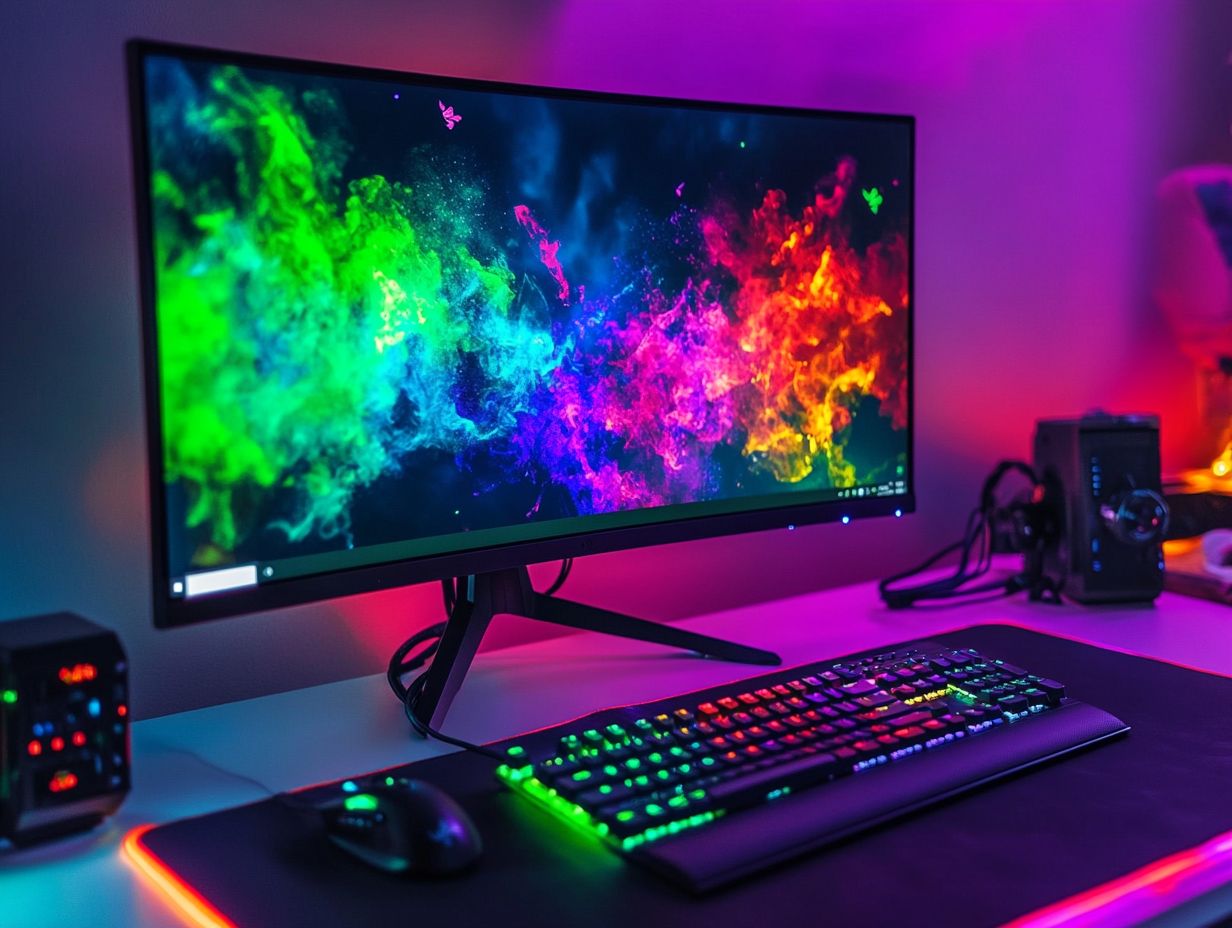
Understanding Gaming Monitors
Knowing your gaming monitors can supercharge your gameplay! With rapid advancements in display technology, selecting the right monitor can elevate your gaming setup to new heights.
From 4K monitors to ultrawide displays, the market offers a range of options for you to explore. Key factors like refresh rate, response time, and image sharpness are vital for a seamless gaming experience.
Understanding visual artifacts and competitive gaming demands helps you make informed decisions tailored to your unique gaming needs.
What Makes a Monitor Ideal for Gaming?
An ideal gaming monitor combines various features to enhance your gaming experience. Key aspects include refresh rate, response time, pixel responsiveness, and image sharpness.
A high refresh rate, measured in hertz, is vital for smoother visuals and improved gameplay fluidity. Refresh rates of 144Hz or higher allow you to see action unfolding with clarity, giving you a competitive edge.
Low response time is equally important; it reduces motion blur and ghosting effects, ensuring rapid movements are rendered seamlessly. Combining these attributes with excellent pixel responsiveness and sharp images creates an environment where every frame counts during critical gaming moments.
This combination of features transforms ordinary gaming into an immersive experience that keeps you engaged and ahead of the competition.
Key Features to Look for in a Gaming Monitor
When searching for the perfect gaming monitor, prioritize key features to ensure an exceptional gaming experience while considering your budget.
Refresh Rate and Response Time
Refresh rate and response time are critical metrics that define motion clarity and overall fluidity in your gaming visuals.
A higher refresh rate means your screen updates images more frequently, minimizing lag and creating a smoother, more immersive environment.
Conversely, a lower response time allows pixels to change colors rapidly, reducing ghosting effects during fast-paced gameplay.
Understanding these specifications helps you select monitors that meet your requirements while elevating your overall performance.
Resolution and Panel Type

The resolution and panel type determine how clear and deep your visuals are. You can choose from 1080p to stunning 4K monitors.
These options are essential for crafting an immersive gaming experience. Higher resolutions result in sharper images, while lower ones might leave you longing for detail.
Each panel technology offers unique benefits. IPS panels are famous for their vibrant colors and wide viewing angles, making them ideal for visually intensive games.
Conversely, TN panels excel in faster response times. They cater to competitive gamers who prioritize speed above all else. Meanwhile, OLED monitors deliver exceptional contrast ratios and deep blacks, elevating visual storytelling.
By understanding these distinctions, you’ll be ready to choose the perfect monitor that aligns with your gaming needs and preferences.
Adaptive Sync Technology
Technologies like Nvidia G-Sync and AMD FreeSync are essential. They stop screen tearing and make your gaming smoother.
These advanced features dynamically align your monitor’s refresh rate with your graphics card’s frame rate. This ensures every movement flows smoothly, even during intense gameplay.
Reducing input lag and stuttering lets you dive deep into your virtual worlds, whether racing through breathtaking tracks or battling in an online arena.
These sync technologies do more than improve visuals; they significantly influence your performance. With a seamless experience, you’ll react with precision and strategize your next move in high-stakes situations.
Connectivity Options
Connectivity options matter when choosing a gaming monitor. They affect how well your monitor works with your gaming PC and devices.
For example, HDMI is a popular interface supporting video and audio transmission, making it perfect for consoles and GPUs.
DisplayPort, on the other hand, offers higher bandwidth and refresh rates, delivering a smoother visual experience. This is especially important for competitive gaming.
Consider the latest versions, like HDMI 2.1, supporting 4K resolution at 120Hz, or DisplayPort 1.4, known for handling higher resolutions and refresh rates for peak monitor performance.
Don’t overlook USB-C ports; they’re increasingly common and provide versatile connections with many modern devices, including laptops.
Additional Considerations for Gaming Monitors
When selecting a gaming monitor, contemplate several key factors: size, aspect ratio, ergonomic design, and eye care features.
Each of these elements can greatly enhance your comfort and usability during extended gaming sessions. This ensures your experience is not only immersive but also enjoyable.
Size and Aspect Ratio
The size and aspect ratio of your monitor greatly affect your immersion. A larger display makes you feel part of the game.
A larger display envelops you in vibrant environments. The aspect ratio is key to this experience.
Take ultrawide monitors, for example; they typically feature a 21:9 aspect ratio. This offers a broader field of view, allowing you to appreciate more of the scene without the hassle of multiple screens.
This enhances depth perception and helps you catch subtle movements, giving you that coveted competitive edge.
Traditional 16:9 ratios may limit your peripheral vision but still deliver a focused gaming experience. Ultimately, choosing the right size and aspect ratio can significantly elevate your enjoyment and performance.
Ergonomic Design and Eye Care Features
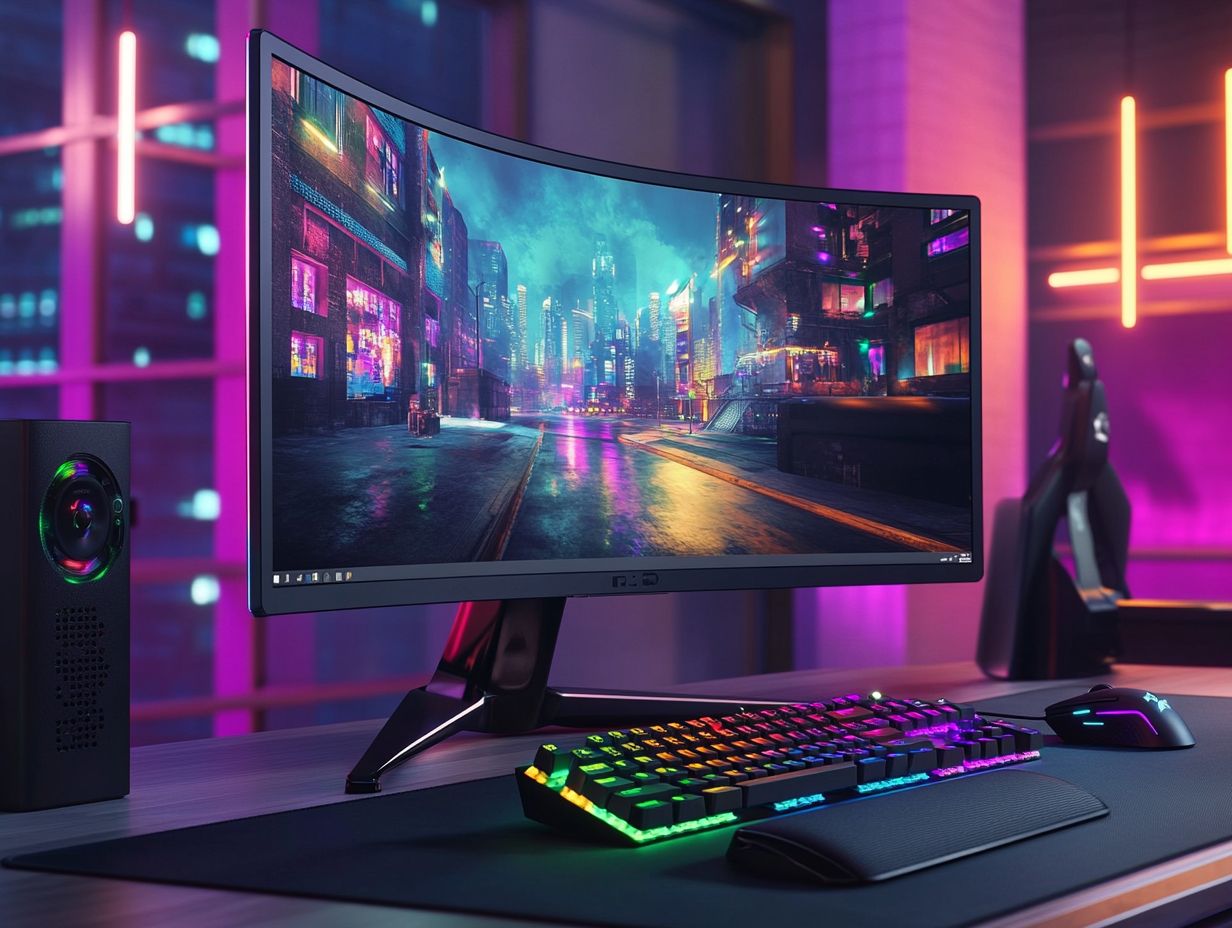
Ergonomic design and eye care features are essential for you as a gamer. Spending long hours in front of screens can lead to discomfort and strain.
Today s games often require marathon sessions filled with intense graphics and fast action. This makes ergonomic design and eye care features even more critical.
For example, local dimming is a feature that adjusts screen brightness based on what s happening on-screen. It helps reduce eye fatigue by delivering deeper blacks and vibrant colors.
Ergonomic elements, such as contoured chairs and well-designed peripherals, support your posture. They also help you stay focused and enjoy the game longer.
Prioritizing these enhancements lets you dive deeper into your gaming world and boosts your comfort!
Choosing the Right Gaming Monitor for Your Needs
Selecting the perfect gaming monitor that aligns with your unique preferences requires thoughtful evaluation. Consider both your budget and the features that can elevate your gaming experience.
Factors to Consider and Best Options on the Market
When looking for the best gaming monitors, consider factors like model reputation and features for gaming enthusiasts. The Asus ROG series stands out for its exceptional refresh rates and vibrant color accuracy, making it a fantastic choice for competitive gamers.
The Acer Predator offers versatile features like G-Sync compatibility and ultra-fast response times. It’s perfect for adrenaline-fueled action games.
If comfort is your priority, the Dell S2417DG provides QHD resolution and ergonomic design for a pleasant viewing experience during marathon gaming sessions.
Meanwhile, BenQ Zowie models are crafted specifically for esports, focusing on customization and minimal input lag. Each of these monitors caters to unique preferences, ensuring a perfect fit whether you’re a casual gamer or a seasoned pro.
Frequently Asked Questions
What features should a gaming monitor have?
A gaming monitor should have a high refresh rate, low input lag, and fast response time. Understanding what makes a good gaming monitor for competitive play helps ensure smooth gameplay and minimal motion blur.
Why is a high refresh rate important in a gaming monitor?
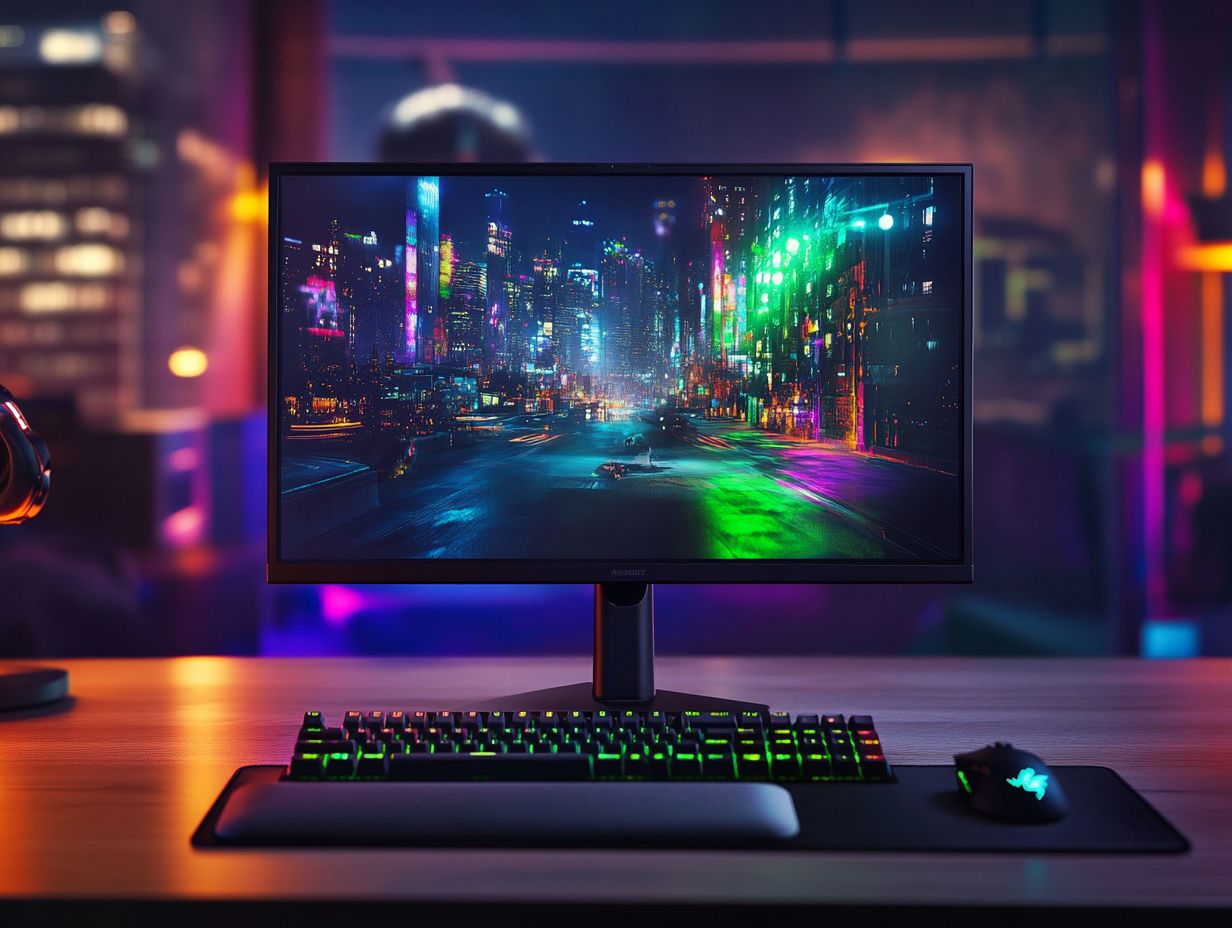
A high refresh rate, usually measured in Hertz (Hz), refers to how often the monitor refreshes the image per second. A higher refresh rate delivers a smoother and more responsive gaming experience.
What is input lag and why is it important for gaming monitors?
Input lag is the delay between your action and what appears on the screen. Low input lag is crucial for gaming because it minimizes the delay between your commands and the game s response.
How does the response time of a gaming monitor affect gameplay?
The response time measures how quickly a pixel changes color. A fast response time, typically measured in milliseconds (ms), reduces motion blur, delivering a clearer image in fast-paced games.
What other features should I look for in a gaming monitor?
Look for high resolution, adjustable stands, and support for adaptive sync technologies like G-Sync or FreeSync. These features can enhance your gaming experience.
Are curved screens better for gaming?
Curved screens can provide a more immersive experience and reduce eye strain with a more natural viewing angle. However, they don’t significantly impact gameplay, so it ultimately comes down to personal preference.

